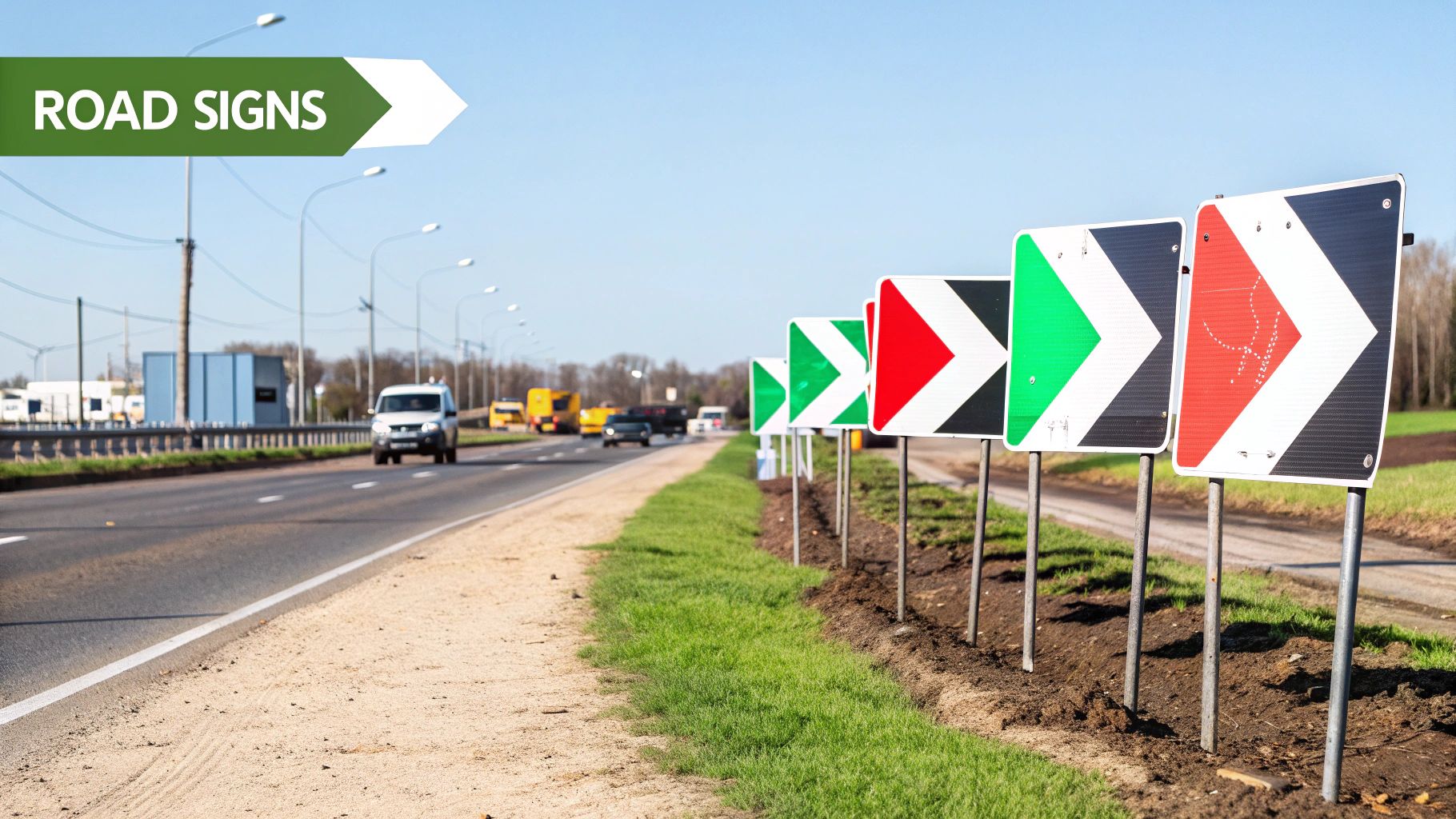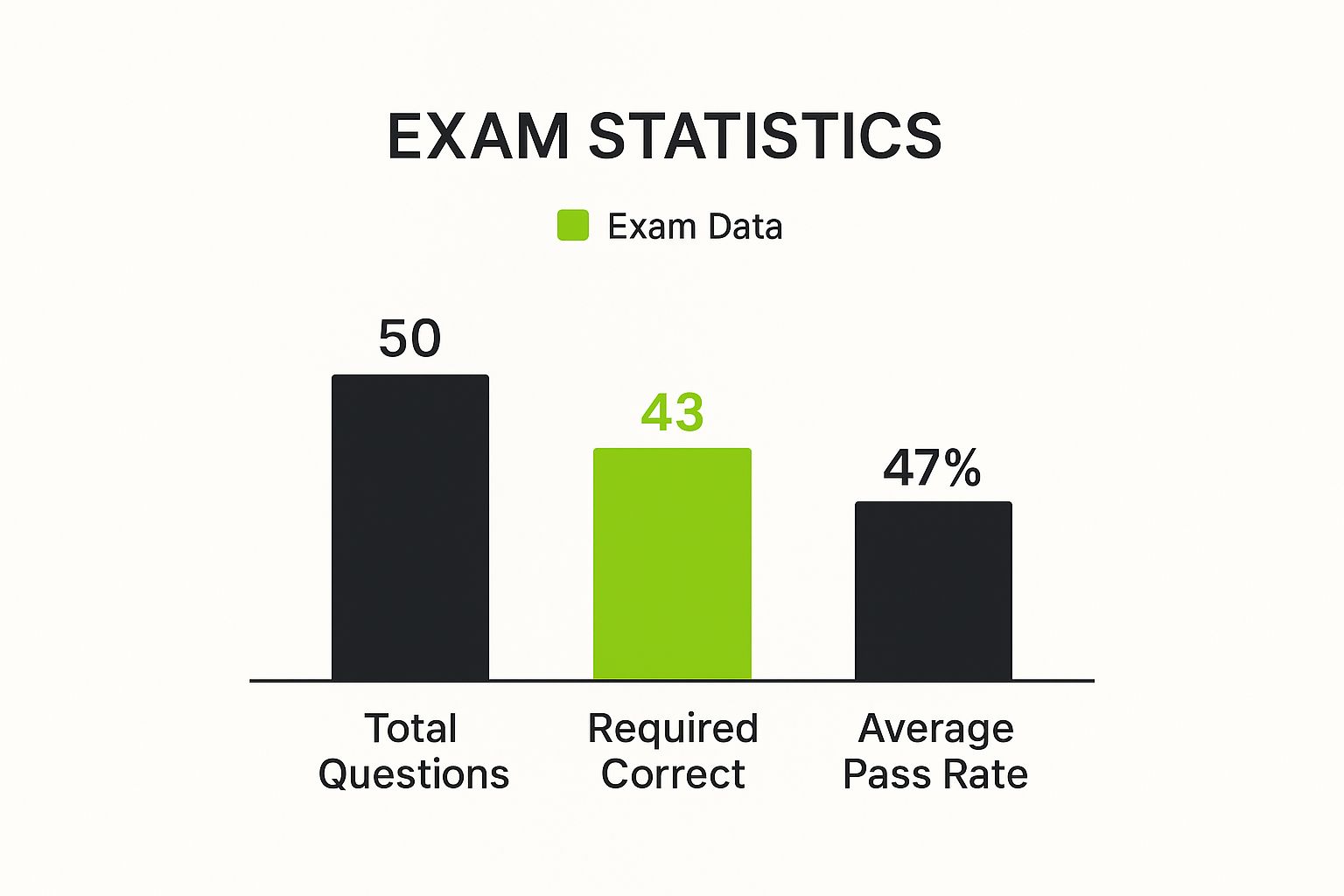Understanding What You're Really Up Against

The UK driving theory test can seem like a significant obstacle on the road to obtaining a driving licence. This section clarifies the test's actual requirements, breaking down both the multiple-choice questions (MCQs) and the hazard perception test (HPT) to provide a clear overview of their structure and purpose.
Deconstructing the Multiple-Choice Questions
The MCQ section goes beyond simply memorizing the Highway Code. It focuses on applying that knowledge to practical driving scenarios, essentially previewing the decisions you'll make on the road.
For example, questions might cover stopping distances under various weather conditions, requiring more than just recalling basic figures. Therefore, understanding the reasoning behind the rules is as important as knowing the rules themselves.
This section dispels common misunderstandings, such as the notion of "easy" questions. Every question evaluates your grasp of safe driving practices, and even seemingly simple questions can have underlying complexities. Furthermore, the questions are randomly selected from an extensive database, so rote memorization alone won't suffice.
Unveiling the Hazard Perception Test
The HPT often presents a challenge to learners, but it can be mastered with the correct approach. This section assesses your ability to identify developing hazards, not merely static ones.
Recognizing the difference between a parked car (static) and a pedestrian about to enter the road (developing hazard) is crucial. The test evaluates your reaction time to these developing hazards.
Many learners mistakenly believe that clicking more frequently leads to a higher score. However, the test penalizes inaccurate clicks, so clicking only when a hazard is genuinely developing is essential. This requires practice and a sharp eye for anticipating potential dangers.
The UK driving theory test is a vital step towards a full driving licence. While specific theory test pass rates aren't widely reported, the overall trend in driving test pass rates (including both theory and practical) offers valuable insights. The overall pass rate increased to 48.9% in the first quarter of 2025.
This positive trend could extend to theory tests as well, underscoring the importance of thorough preparation. You can find more detailed statistics here: https://www.gov.uk/government/collections/driving-tests-and-instructors-statistics
By understanding the true nature of both the MCQ and HPT sections, you'll be better prepared to strategize effectively and approach your theory test with confidence. This preparation lays the groundwork for safe driving habits long after you've passed the test.
What Current Pass Rates Mean For Your Success

Understanding current driving theory test pass rates can significantly impact how you prepare and how confident you feel going into the exam. It's not just about the numbers themselves; it's about understanding the trends and what they tell us about effective study strategies. We'll explore how these insights can shape your approach and boost your chances of first-time success.
Fewer Tests, Higher Pass Rates: A Positive Trend
Driver and Vehicle Standards Agency (DVSA) statistics reveal a compelling trend: fewer people are taking the theory test, yet pass rates are rising. This might seem odd, but it highlights a key point: quality preparation is more important than the number of test-takers. This suggests those taking the test are better prepared than in previous years, emphasizing the importance of focused, strategic study.
Imagine a scenario where many people booked tests due to backlog pressure, without adequate preparation. This would lower the overall pass rate. However, a decrease in test numbers alongside a rising pass rate suggests a shift towards more dedicated learners.
The UK driving theory test pass rates fluctuate, influenced by demand and system backlogs. The pass rate in the first quarter of 2025 was 48.9%, slightly higher than pre-pandemic averages and up from 47% the previous year. This improvement happened despite an 18.3% drop in tests taken during the same period. More detailed statistics can be found here: Higher Pass Rates in 2025.
Why Smarter Preparation Is Key
The rise in pass rates isn't about easier tests; it's about changing learner behavior. More people recognize the value of thorough preparation, using effective resources, and adopting a more strategic approach. This means simply cramming the night before is less likely to work.
Instead, focused study, regular practice, and truly understanding the Highway Code are more crucial than ever. For more information on preparing for your theory test, check out this helpful guide: The Driving Theory Test: A Handy Guide for Learner Drivers.
Learning From Success: Insights From Driving Schools
Driving instructors across the UK have noticed a difference in how successful candidates approach the test. Those who pass on their first try often share key characteristics:
- Consistent practice: They review the material and take practice tests regularly.
- Strategic learning: They focus on understanding the concepts, not just memorizing answers.
- Realistic self-assessment: They honestly evaluate their weaknesses and dedicate extra time to those areas.
Those who struggle often lack consistent effort, relying on last-minute cramming and failing to address their weaknesses. By understanding these patterns, you can tailor your preparation to maximize your chances of passing the first time. Practice tests are invaluable for gauging progress and pinpointing areas needing more attention, allowing you to refine your study plan and focus your efforts effectively.
Mastering Multiple Choice Beyond Basic Memorization

The multiple-choice section of the UK theory test isn't simply about memorizing the Highway Code. It requires applying knowledge to real-world scenarios, anticipating hazards, and making safe driving decisions. This section explores the analytical techniques successful candidates use to navigate challenging questions and avoid common mistakes. Passing requires understanding the reasoning behind the rules, not just rote memorization.
Decoding Tricky Questions: More Than Just Memory
Many learners try to memorize answers to practice questions. However, the actual test pulls questions from a large database, rendering this strategy less effective. Instead, focus on understanding the principles behind the rules. This enables you to apply your knowledge to new situations, mirroring real-world driving.
For example, grasping how stopping distances are affected by road conditions, visibility, and vehicle speed allows you to answer various related questions. This is true even if you haven't encountered the exact scenario in practice materials.
Understanding right-of-way rules in different contexts, like roundabouts and crossroads, also equips you to answer a broader range of questions.
Time Management and Eliminating Wrong Answers
Managing your time effectively is essential during the multiple-choice section. Rushing can lead to avoidable errors. Develop a pacing strategy. If a question is difficult, mark it and return later if time permits. This prevents dwelling on one question and maximizes your potential score.
Strategically eliminating incorrect answers can significantly improve your chances. Often, two answers are obviously wrong, leaving you with two plausible options. This narrows down the possibilities and lets you make more informed decisions based on your Highway Code knowledge.
To help illustrate effective preparation strategies for each question category, the table below provides a breakdown of common topics, average success rates, and key preparation methods:
Common Theory Test Question Categories and Success Strategies
| Question Category | Typical Topics | Success Rate | Key Preparation Strategy |
|---|---|---|---|
| Rules of the Road | Speed limits, road signs, traffic signals | 85% | Focus on understanding the meaning and application of each rule. |
| Road and Traffic Signs | Warning signs, regulatory signs, information signs | 90% | Visualize scenarios involving each sign and practice quick identification. |
| Vehicle Handling | Stopping distances, maneuvering, vehicle safety checks | 75% | Utilize online resources and videos to understand vehicle dynamics. |
| Hazard Awareness | Anticipating hazards, reacting to emergencies, pedestrian safety | 65% | Practice visualizing different scenarios and appropriate responses. |
| Vulnerable Road Users | Cyclists, pedestrians, motorcyclists | 80% | Understand the specific rules and considerations for these road users. |
This table highlights the importance of tailored preparation for each question category. Focusing on areas with lower success rates, such as hazard awareness and vehicle handling, can significantly improve your overall performance.
Applying Knowledge to Complex Scenarios
The multiple-choice section presents scenarios involving stopping distances, right-of-way, and vehicle safety checks. These questions assess your ability to apply learned principles to dynamic situations. Visualizing these scenarios as you read can help bridge the gap between theory and practice, leading to more accurate answers.
For example, imagine a pedestrian stepping onto a zebra crossing. Visualizing the scenario – including your vehicle's speed, the pedestrian's location, and the surrounding traffic – helps you determine the correct action according to the Highway Code.
By mastering these analytical techniques, you move beyond memorization and develop a genuine understanding of safe driving principles. This prepares you not only for the test but also for the road.
Conquering Hazard Perception Like A Pro
Hazard perception is a frequent stumbling block for theory test candidates. But with the right preparation, it's entirely manageable. This section explores the visual skills and timing strategies that contribute to success. We'll examine how understanding the difference between static and developing hazards can significantly improve your test performance and, ultimately, your real-world driving.
Static vs. Developing Hazards: A Crucial Distinction
A static hazard represents a potential danger that doesn't necessitate immediate action. A parked car, for example, is a static hazard. You should be aware of it, but it doesn't require clicking in the hazard perception test. A developing hazard, on the other hand, presents a situation that demands a response. A pedestrian stepping into the road is a developing hazard, and this is precisely when you should click. Recognizing this distinction is fundamental to success.
Recognizing Common Hazard Perception Scenarios
The hazard perception test uses realistic video clips. Familiarizing yourself with common scenarios will help you anticipate potential hazards:
- Pedestrians: Look for pedestrians at crossings, bus stops, or near parked cars.
- Cyclists: Be particularly mindful of cyclists, especially in traffic and at junctions.
- Emerging Vehicles: Watch for cars pulling out from side streets or driveways.
- Changing Traffic Conditions: Be prepared for changing speed limits, traffic lights, and the actions of other road users.
You might be interested in: How to master Hazard Perception.
Mastering the Art of Clicking: Timing is Key
Clicking too early or too late will affect your score. The key is to click as the hazard begins to develop, not when it's already fully developed. For example, click when a pedestrian starts to step onto the road, not when they are already halfway across.
Over-clicking is penalized. Avoid clicking repeatedly in the hope of a higher score. This strategy will actually lower your score. Practicing with mock tests is essential for developing accurate timing.
Building Real-World Driving Awareness
The skills you hone for the hazard perception test are directly applicable to real-world driving. By learning to anticipate potential hazards, you become a more observant and safer driver. This proactive approach heightens your awareness and reduces the risk of accidents.
Historically, the UK's driving test system has experienced disruptions. The COVID-19 pandemic, for example, significantly impacted test numbers and pass rates. In March 2025, there were 162,259 driving tests conducted, a decrease from 184,317 in March 2024. However, the pass rate increased from 46.9% to 49.0% during the same period. This data suggests that while fewer tests were taken, candidates were generally better prepared. Find more detailed statistics here: UK Driving Test Data.
Practice Makes Perfect: Honing Your Skills
Practice is paramount for improving your hazard perception skills. Utilize online resources and mock tests to familiarize yourself with the test format and various scenarios. Regular practice enhances your ability to identify hazards early and click at the right moment, increasing your confidence and your chances of passing the theory test. This preparation also translates to improved driving skills for real-world situations. Consistent effort and a strategic approach are the keys to success.
Building A Study Plan That Actually Delivers Results
Random studying and cramming won't get you a passing score on your theory test. A strategic, systematic approach is essential for effective knowledge building. This section outlines proven study schedules adaptable to various learning styles and time constraints, whether you're preparing quickly or studying over several months.
Tailoring Your Study Schedule to Your Timeline
A structured study plan is your roadmap to success. It maintains focus, ensures comprehensive coverage of the material, and allows you to monitor progress. The ideal plan depends on your learning style and available time.
-
Intensive Revision (2 Weeks): Dedicate 2-3 hours daily, focusing on practice questions and mock tests. Intensively review the Highway Code. Aim for 3-4 practice tests per week.
-
Steady Preparation (1 Month): Allocate 1-2 hours daily, balancing Highway Code study with hazard perception practice. Aim for 2-3 practice tests weekly, and review challenging areas.
-
Long-Term Learning (3 Months): Study 30-60 minutes daily. Focus on understanding the Highway Code's principles. Gradually incorporate hazard perception practice and take 1-2 practice tests weekly to track your progress.
These are examples; adjust them to your needs. To help you further visualize potential study plans, take a look at the table below:
To help you structure your study time, we've outlined some recommended schedules based on different preparation timelines:
| Timeline | Daily Study Time | Focus Areas | Practice Tests per Week | Success Indicators |
|---|---|---|---|---|
| 2 Weeks | 2-3 hours | Practice questions, mock tests, intensive Highway Code review | 3-4 | Consistent scores above 90% on mock tests |
| 1 Month | 1-2 hours | Balanced Highway Code study and hazard perception practice | 2-3 | Steady improvement in mock test scores, addressing weak areas |
| 3 Months | 30-60 minutes | Understanding Highway Code principles, gradual hazard perception integration | 1-2 | Consistent progress in mock test scores, comprehensive understanding of the code |
This table provides structured study plans for various timeframes, helping you organize your preparation and track progress effectively. Remember to adjust these suggestions to fit your individual learning style and available time.
Choosing the Right Study Materials
Successful candidates often combine several resources:
-
The Official Highway Code: The essential foundation for the theory test.
-
Theory Test Practice Apps: A convenient way to test your knowledge on the go.
-
Mock Theory Test Websites: Offer realistic test simulations.
-
Driving Instructor Guidance: Personalized feedback from a qualified instructor can be invaluable.
Balancing Highway Code Learning and Hazard Perception Practice
Proficiency in both multiple-choice questions and hazard perception is crucial. Find a balance that suits you. Some dedicate specific days to each, while others alternate within each study session. Experiment and find what works best for you.
When to Book Your Test: Recognizing Readiness
Book your test strategically. Don't book too early if your practice test scores are inconsistent. Aim for a consistent 90% or higher on mock tests before booking.

This infographic shows key data points: 50 total questions, 43 required to pass, and a 47% national average pass rate. While 43 correct answers are needed to pass, aiming higher in practice increases your chances of success on the actual test.
Effective Study Habits: Beyond Just Reading
Active recall is a powerful technique. After reading, try recalling key points without looking. This reinforces learning and identifies areas needing review. Simulate test conditions by timing practice tests to improve time management during the exam.
Test Day Success From Arrival To Results
Your theory test performance relies on more than just Highway Code knowledge. Practical aspects can significantly influence your outcome. This guide walks you through the test day, from arrival to results. We'll cover essential documents, navigating the test centre, managing nerves, and common mistakes.
Arriving Prepared: Essential Documents and Expectations
Arriving prepared sets a positive tone. Ensure you have your provisional driving licence. Without it, you can't take the test and will lose your fee. Familiarize yourself with the test centre location to avoid stress. Plan your route, considering traffic, and arrive at least 15 minutes early.
Inside the Test Centre: Navigating the Environment
Test centre staff will guide you through the process, checking your licence and explaining procedures. You’ll be assigned a computer with instructions. Take a deep breath and focus. The system is designed to be user-friendly.
Managing Test Day Nerves: Staying Calm
Pre-test nerves are normal. Use these strategies:
- Deep breathing: Slow, deep breaths regulate your heart rate and calm your mind.
- Positive self-talk: Focus on your preparation and strengths.
- Visualization: Visualize successfully completing the test.
- Stay hydrated: Dehydration can increase stress. Drink water before and during the test if allowed.
Tackling the Multiple-Choice Section: Time Management and Focus
Manage your time wisely. If a question is difficult, mark it and return later to maximize your score. Read each question carefully, noting keywords and eliminating incorrect answers. Stay calm and trust your preparation.
Conquering Hazard Perception: Effective Reactions
In the hazard perception section, click only when a hazard is developing, not when it’s static. Avoid over-clicking, a common mistake. Anticipate potential dangers and click when the hazard begins.
From Test Completion to Results: Understanding the Process
You'll receive your results immediately. The multiple-choice pass mark is 43 out of 50. For hazard perception, it's 44 out of 75. Staff will explain your score and offer feedback.
What If You Don't Pass? Next Steps
Don't be discouraged if you don’t pass the first time. You can rebook quickly. Analyze your results to identify areas for improvement. Focus your study on weak areas. Learn more in our article about How to master your driving test. Additional practice and targeted revision will increase your next attempt's success. Persistence and a positive attitude are key. Focus on the learning process.
Key Takeaways
Passing the UK driving theory test is a crucial step towards earning your driving licence. This section provides essential strategies for success, a personalized roadmap incorporating insights from successful candidates and experienced instructors. We'll cover actionable steps for both the multiple-choice and hazard perception sections, outlining realistic timelines and potential warning signs that might indicate a need for more focused preparation.
Multiple-Choice Mastery: Beyond Rote Learning
Understanding the material is more important than simply memorizing the Highway Code. The theory test assesses your ability to apply principles to real-world scenarios. Focus on why rules exist, not just what they are. For example, understanding the reasoning behind a specific speed limit for a particular road type is more beneficial than just memorizing the number.
Effective time management is key. Develop a pacing strategy and allocate time per question. If you're unsure of an answer, mark it and move on. Return to it later if time allows. This prevents getting stuck and maximizing your overall score.
Elimination techniques can also be helpful. Often, you can quickly dismiss two obviously incorrect answers, increasing your odds of selecting the right one.
Finally, practice is paramount. Take numerous practice tests to familiarize yourself with the question format, identify weak areas, and build confidence. Aim for consistently scoring above 90% on practice tests before booking your official test.
Hazard Perception: Sharpening Your Anticipation
Distinguishing between static hazards (like a parked car) and developing hazards (such as a pedestrian about to cross the road) is critical. Click only for developing hazards. Clicking for static hazards will lower your score.
Accurate clicking timing is also essential. Click as the hazard begins to develop, not when it's fully developed. This tests your anticipation, reflecting real-world driving. Hazard perception practice clips will refine this skill.
Avoid over-clicking. Repeated clicking doesn't improve your score and can result in penalties. Prioritize accuracy over frequency.
Building Your Study Plan: A Roadmap to Success
Create a personalized schedule tailored to your learning style and available time. A consistent, manageable schedule, whether it's a few hours daily or an hour weekly, is more effective than sporadic cramming.
Utilize diverse resources. Combine the official Highway Code with practice apps, online mock tests, and potentially guidance from a qualified driving instructor.
Honest self-assessment is vital. Identify your weaknesses and dedicate more time to improving in those areas. Track your progress on practice tests and adjust your study plan as needed. Consistently scoring below 90% suggests postponing your test and continuing practice.
Test Day Triumph: From Preparation to Results
Ensure you have your provisional driving licence. Arriving without it will result in forfeiting the test and the fee.
Arrive early, ideally 15 minutes before your scheduled time. This allows time to find the test centre, register, and compose yourself, minimizing stress.
Manage pre-test nerves through deep breathing, positive self-talk, and visualization techniques.
Maintain focus during both sections of the test, avoiding distractions. Trust your preparation and approach the test with confidence.
Passing the theory test requires diligent preparation and a strategic approach. These key takeaways provide a solid foundation for success. Remember, the goal is not just passing the test but acquiring the essential knowledge and skills for safe and responsible driving. Ready to begin your driving journey? Book a course with Fast Pass Driving Courses and accelerate your path to a driving licence: Fast Pass Driving Courses

